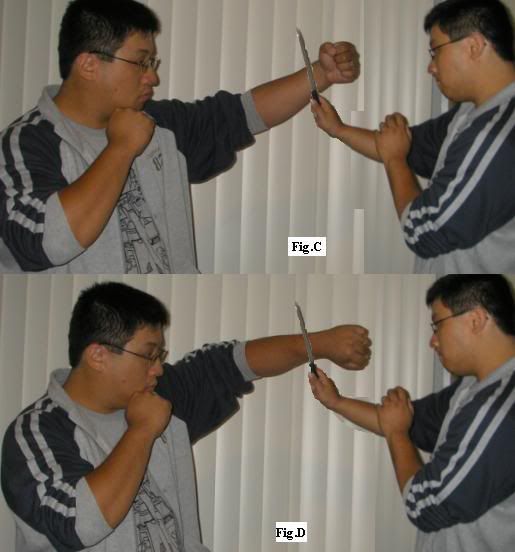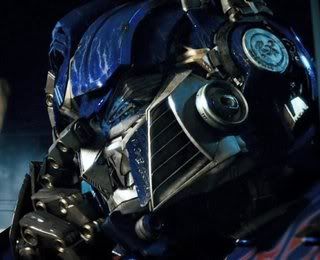-
5th March 2008, 05:11 PM
#31

I'd rather not discuss that publicly. As Mr Miyagi taught us, we train to fight so that we may never have to. Learning self defence is a lot like buying insurance or wearing a seat belt... you hope that you'll never need it, but when it happens you're mighty glad that you have it.
When buying insurance you want to get something decent. Fortunately safety equipment and devices like seatbelts, helmets etc comply to a regulated government standard. There is no such standard for martial arts.
If you're interested in training for practical self defence, I would personally recommend training in a traditional style and preferably at a school whose students do NOT compete in matches/tournaments. I'm quite skeptical of this whole "mixed martial arts" business. It promises a lot but I've yet to see any substantial delivery - and in an age of post-submachinegun warfare, I doubt we'll ever see that promise fulfilled.
Competition fighting: Not recommended in a real fight

Traditional fighting: Battle-hardened and proven in centuries of warfare

-
6th April 2008, 07:30 PM
#32

Another discussion about roundhouse punches - what I consider to be the 'right' and 'wrong' way of doing them, or if you like, a more ideal/optimal way of throwing a roundhouse punch.
For those who don't know, a roundhouse punch is a punch which arcs and hits the target (typically your opponent's head) from the side, 'drawing' a semi-circle in the air.
Sounds simple but surprisingly I see a disturbing number of people who do it incorrectly - and I'll explain why.
Now here is what I consider to be a correct roundhouse punch.

(See Fig.B)
The main thing to take note of is that the base knuckles are turned inward - i.e.: the base knuckles are the ones which will hit the target
There are two advantages in doing this.
Firstly, by rotating the knuckles inward, you are generating additional torque which in turn creates more force in your hit.

The second advantage I will discuss later.
Now this is what I consider to be the incorrect way of throwing a roundhouse punch:

(See Fig.A)
Even though this shot was taken from a computer game, believe it or not, but I've seen several instructors actually teach their students to roundhouse punch like this. The main difference here is that the fist is not rotated to turn the base knuckles inward, rather, the punch is impacting with the mid-finger knuckles. I've heard a few instructors describe it as "holding a coffee mug" when teaching this punch.
IMO there are two disadvantages of throwing a roundhouse punch like this. Firstly, because there's less rotation, there is naturally less torsion.
Here's what the two roundhouse punches look side by side:

Now onto the second advantage/disadvantage with these two different methods of roundhouse punching.
The roundhouse punch in Fig.B is exposing the 'outside' of the forearm/wrist toward the opponent whereas the roundhouse punch in Fig.A is exposing the 'inside' of the forearm/wrist toward the opponent.
The 'inside' of your wrist houses the flexor tendons which are important for operating your hand and fingers.

By exposing the inside of your wrist toward an opponent you are putting those tendons in danger - they can be hit or cut by a blade or even knuckles (Leopard Paw is especially used for cutting)

The inside of your wrist is quite soft - feel for yourself. And due to the relative lack of muscle around that area, it's not a part of the body that you can substantially condition to become more resistant to hits (i.e.: it's a part of your body that you can't really toughen up - it will always be soft). These are the same tendons that you use to write and type with and it's the same tendon that becomes sore if you have writer's cramp or RSI.

The 'outside' of the wrist on the other hand is substantially harder and tougher, and it can be conditioned/toughened up to be more resistant. Even if you are cut with a blade, it is far less crucial than being cut on the inside.
If you are cut on the inside and the flexor tendons are severed, then your hand will become basically useless - you won't be able to grab or form a fist. Getting cut on the outside will still hurt, but a superficial cut won't incapacitate your hand.

Fig.C illustrates how the roundhouse punch from Fig.A exposes the flexor tendons to a blade
Fig.D illustrates how the roundhouse punch from Fig.B doesn't expose the flexor tendons to a blade
Sure, ideally you would prefer not to be cut at all - but if you're up against an opponent with a knife, the odds are against you and there's a real chance that you will be cut. But if you're going to get cut, you would rather get cut in a way that doesn't compromise your fighting form - i.e.: you want to be able to continue fighting even after receiving a cut. That's as best as I can describe it without going into details about how to receive a cut, which is something that is beyond the scope of what I'm discussing atm.
-
6th April 2008, 07:36 PM
#33

Oh my gosh there're two Goks!!! One is already too many~ 
(Well at least it looks like one will kill the other...  )
)
-
14th October 2008, 09:17 PM
#34

The Anatomy Of Fear and How It Relates To Survival Skills Training
This is an excellent well-researched paper analysing the nature of fear in combat and how to deal with it. A must-read.
-
14th October 2008, 09:46 PM
#35

What styles do your currently train in now?
-
14th October 2008, 10:26 PM
#36

7-Star Northern Praying Mantis. You?
-
14th October 2008, 10:38 PM
#37

Mainly Liuhebafa (very different from the Sydney ones), with the most basic exercises from Lama, Xingyi and Bagua as supplements. My teacher used to train in 7-Star Mantis for years, so I also had some Mantis training.
-
15th October 2008, 08:46 PM
#38

I'm not that familiar with Six-Harmony Bafa in Sydney anyway so I wouldn't know the difference - I've seen a tiny bit of Six-Harmony Mantis, but I'm too ignorant of either style to know if there's any similarity between those styles. 
I've had a little bit of Jiangrongqiao Bagua training. Can you show me any decent videos of Liuhebafa?
I find it hard to find decent videos on Seven Star Mantis... the late Brendan Lai was pretty good and the video there shows him demonstrating some good techniques... but I don't like the style of his applications demonstrations. He has this annoying habit of having his assistant attacking him really slowly and leaving himself out there for Lai to counter really quickly, which is cheating. I can understand demonstrating techniques in slow-motion, but if so then the entire technique should be at the same pace - both the attack and the counter. If he wants to demonstrate the technique at full speed then the assistant should be attacking him at full speed. Too many times that dude in the red is essentially just a mobile dummy for Lai rather than simulating an actual attacker. His techniques are good though... I just think that they could've been better demonstrated (and I don't know what's up with the shouting).
-
28th October 2008, 08:32 PM
#39

This is a pretty good video of Seven Star Mantis.
I found this video on Liuhebafa - do you think it's any good? I can see some similarities to Bagua and Taichi in this form (e.g.: cloud carrying etc). 
-
3rd May 2009, 04:50 PM
#40

You know what's even better than learning from your mistakes? Learning from other people's mistakes! Especially in martial arts where making massive stuff-ups in a fight can be very painful if not deadly...
Watch the first bit of this sparring video (the black and white footage). Their technique is just downright awful and their sparring just reeks of absolute inattentiveness. It's almost like... this is a what fighting style would look like if it were based on ADHD. (-_-)
How many mistakes can you spot?
I've noted...
+ At 00:15-00:18 the attacker lands a shin kick with far too much ease. The defender is clearly not paying attention to what's happening and doesn't even look like he really wants to be there.
+ The defender's head comes in with his attack and doesn't provide cover for the attacker's hands. Even most noobs know to keep their heads back and cover the attacker's hands. (-_-)


 Posting Permissions
Posting Permissions
- You may not post new threads
- You may not post replies
- You may not post attachments
- You may not edit your posts
-
Forum Rules







 Reply With Quote
Reply With Quote









 )
)

